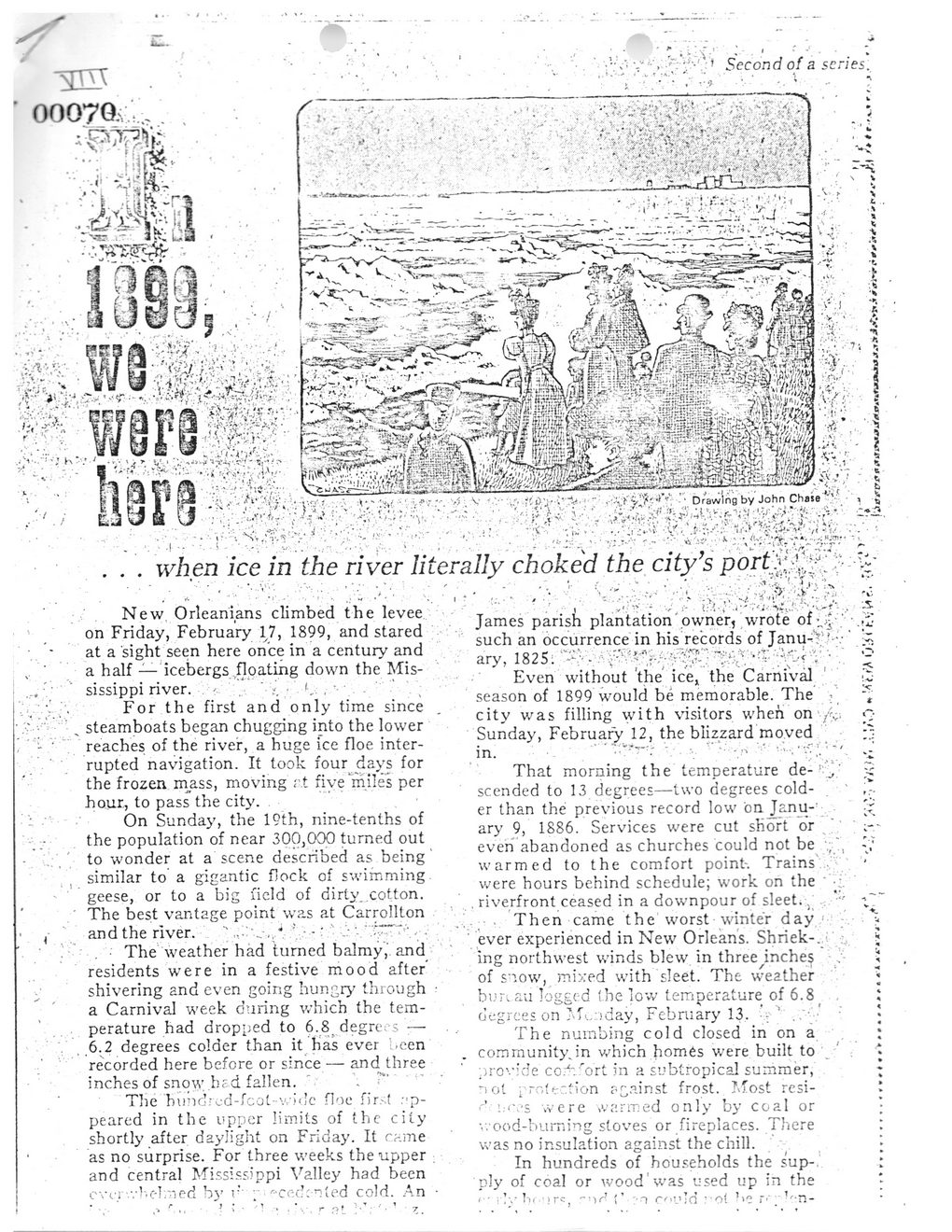This text was obtained via automated optical character recognition.
It has not been edited and may therefore contain several errors.
/ nix 00070 . ■ il - ■'.'j. Tiiht-r^ ..J.niT-C^r . Second of a series. &< t X Xu'- r : S>• y '/•VyXi'v-: ' , - *},-? / r» -v-vj . *•«?>*$$; '•••V'3!.,-:vv' ■ ••■ ;'■ -'4 ■ V ■.vr^'vIVf* Tv ■ • Drawing by John Chase '■■'■"■ g • * vVi ’■ * } »*■ i ?• ' •, «•'’••■ 1' ‘k • '*• • * • ** •• ' ' '•/ • :V V-J' V ' ’ i« V<*' !>■• l’:, 'iKW.r -'•<J ' *?!’' ^ when ice in the river literally choked the city’s port^J^^:-^ per New Orleanians climbed the levee on Friday, February 17, 1899, and stared at a sight seen here once in a century and a half — icebergs floating down the Mississippi river. , r For the first and only time since „ steamboats began chugging into the lower reaches of the river, a huge ice floe interrupted navigation. It took four days for the frozen mass, moving r.t five "miles hour, to pass the city. On Sunday, the 19th, nine-tenths of the population of near 300,000 turned out to wonder at a scene described as being' similar to a gigantic flock of swimming geese, or to a big field of dirty cotton. The best vantage point was at Carrollton and the river. ' J • -: ' <• • The weather had turned balmy, and residents were in a festive mood after shivering and even going hungry through ■ a Carnival week during which the temperature had dropped to 6.8> degrees ■— 6.2 degrees colder than it has ever l.een recorded here before or since — and three inches of snow bed fallen. ' . The bimdred-fcot-widc floe first ;■ p-peared in the upper limits of the city shortly after daylight on Friday. It r.nme as no surprise. For three weeks the upper and central Mississippi Valley had been c\vr.vhc-J:v>ed by r* "cedc-nted cold. An • •SJ James parish plantation' owner, wrote of^l such an occurrence in his records of Janu-^'.'--.- ‘ ary, 1825. V' Even without 'the ice* the Carnival season of 1899 would be memorable. The > city was filling with visitors when on fa. Sunday, February 12, the blizzard moved in. ' ■ That morning the temperature de-'^' scended to 13 degrees—two degrees colder than the previous record low on Janu-' ary 9, 1886. Services were cut short or even abandoned as churches could not be warmed to the comfort point-. Trains were hours behind schedule; work on the ' , riverfront ceased in a downpour of sleet., , Then came the worst winter day1 ever experienced in New Orleans. Shriek-.,; ing northwest winds blew in three inches of snow, mixed with sleet. The weather bureau logged the low temperature of 6.8 . degrees on Monday, February 13. .:■■■ The numbing cold closed in on a community,in which homes were built to _ ‘ . provide co± ,'ort in a subtropical summer, not. i roter.tion p gainst frost. ?%fost resi- ■ ’ »:<vs were warmed only by coal or wood-burning stoves or fireplaces. There was no insulation against the chill. In hundreds of households the sup-, ply of coal or wood was used up in the US IK,-) ■n •of

New Orleans and Louisiana Document (066)